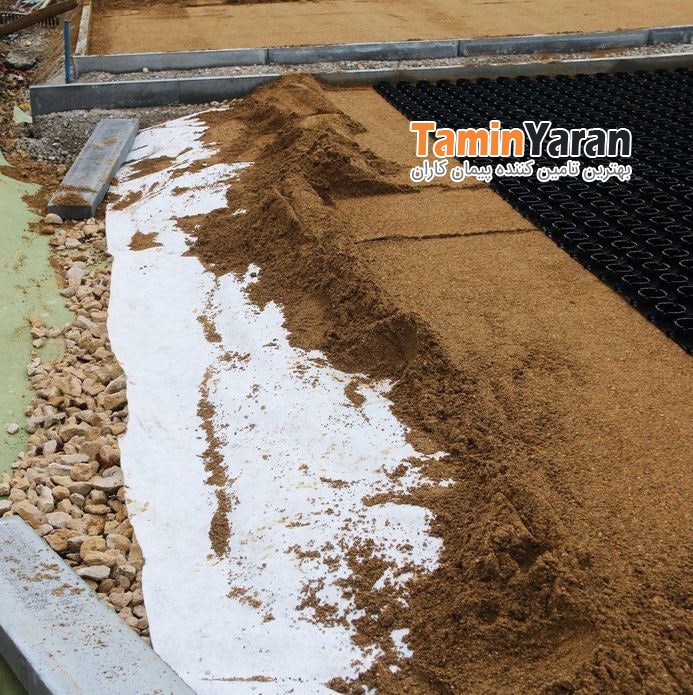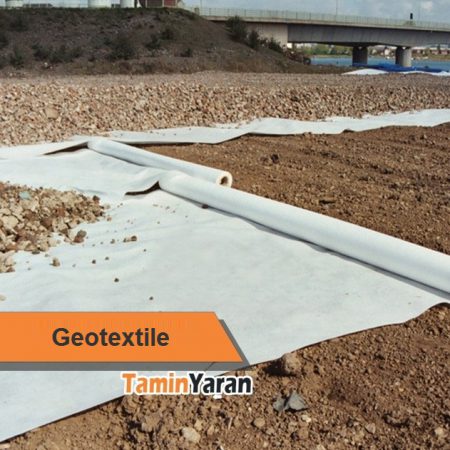توضیحات
What is Geotextile
Geotextile, commonly called industrial felt, is an impermeable geosynthetic sheet that resembles a thin moquette.
Geotextile is made of woven and nonwoven polyester and polypropylene fibers.
When in contact with soil, this product is capable of separation, filtration, reinforcement, and protection.
Geotextiles are commonly fabricated via the sewing, thermal, or chemical method and feature a nonwoven felt-like structure.
Geotextiles can be installed rapidly; are lightweight, strong, and inexpensive; last long; and, above all, are environment-friendly.
They are widely used in construction for leveling and reinforcement.
Their permeable and porous structure has resulted in characteristics such as the capillary property, high water absorption, pressure and impact resistance, and even tar absorption.
All types of geotextiles in different weights and colors, made of polyester and polypropylene
For use in road construction and geosynthetics, substructure, strengthening and packaging of soil and drainage with first-class Iranian product for export to CIS countries.
In white colors and all kinds of colors
Types of geotextile
In a general classification, geotextiles are divided into woven and nonwoven groups.
- Non-woven geotextile
In this type of geotextile, short cuts of fiber are mixed. In other words, a mass of fibers is attached together chemically, thermally, or via needle punch, or a combination thereof.
These properties provide it with superior tear resistance compared to woven felt since the exerted force is carried by more fibers.
Another method of fabricating non-woven geotextile is the calendar heat press, the product of which is called . This product has better mechanical properties than non-woven geotextile. Most importantly, it benefits from selective passage . For projects such as roof gardens, this means that the soil filter blocks the passage of soil but allows water to pass, unlike geotextile.
Nonwoven geotextiles are used in most construction projects.
- Woven geotextile
Woven felt consists of a layer of fabric with distinct warp and weft woven as two perpendicular sets of yarn using weaving machines.
Nonwoven geotextile provides better filtration due to more empty space in the fabric and high strength.
Nonwoven geotextile resembles felt and has an irregular warp and weft texture.
It is suitable for enhancing various properties of soil and asphalt, such as erosion control, drainage, separation, filtration, reinforcement, and protection.
The excellent physical properties of geotextile, such as strength, permeability, high tensile resistance, and high piercing resistance, have led to its increased use.
This industrial felt is available in rolls of different colors and weights and sold in kilograms or square meters.
Due to its polymer nature, geotextile does not degrade in soil and can provide water drainage, material reinforcement, and protection of damp seals, such as geomembrane, for a long time.
Properties of nonwoven geotextile or felt
- Tensile strength
- Compressibility
- Elastic property (causes reinforced soil to recover its shape after external loading)
- High erosion-resistance
- High hydraulicity, leading to better conveyance of water (drainage)
- Long life (30 years)
- Acid and base resistance
- Damage resistance
- Isotropic property, which causes the geotextile to behave similarly in longitudinal and lateral directions.
- High cohesion due to the use of short fibers
- Decay resistance
Benefits of geotextiles
Protection:
One major use of geotextiles is as protective layers for damp seals, such as geomembrane, in geomembrane pool construction.
Specifically, the geotextile layer is spread over the soil bed before the geomembrane layer and protects the latter against potential damage.
This feature is especially useful in mountainous areas or deep pools due to its low cost and fast installation compared to alternatives.

Separation in roadbeds
One reason for road damage is the presence of stones of various sizes in the roadbed during construction. These stones gradually destroy the upper layer due to traffic weight and vibrations.
This damage may result in costs and even health hazards.
Geotextiles are used to separate the layers of road beds during construction.
Two types of textiles separate the soil such that each layer retains its functionality without damaging other layers.

Filtration:
Geotextiles can selectively allow water to pass and prevent upstream fine grains from entering the drainage. Hence, they can replace filters commonly used in drainage systems.
A layer of permeable geotextile can be used between a coarse grain and a fine-grain soil layer to prevent the penetration of fine grains into the coarse grains.
A major application of this property is in earth dam construction.

Drainage property:
Water permeating through geotextile can readily flow and be guided to the specified outlets. This facilitates the use of geotextiles for landfills, behind retaining walls, behind tunnel walls, and under embankments.

Soil erosion control:
One main application of drainage geotextile is in stabilizing and preventing the erosion of jetties and shores.
In continuous erosion control, this product acts as underground drainage and prevents damage to reinforced concrete from wave impact.
Jetties are usually subjected to erosion from water; therefore, using superior materials will reduce prospective maintenance costs.
One of these materials is geotextile, which can be used in constructing jetties, especially in columns in contact with seawater, since it blocks water from entering the structure and minimizes long-term erosion.
Shores are usually at risk of erosion and damage due to wave force and tides.
Various techniques, such as building foundations, are used to mitigate this risk.
The repair costs will be enormous in case of damage.
Geotextiles can be used as protective layers for breakwaters on shorelines. They prevent damage to breakwaters and reduce prospective maintenance costs.
Furthermore, using geotextile bags in the construction of groynes in shore or river beds leads to protection and filtration.
Applications:
- Separator in roads/paving/foundation
- Railway foundation/railway stabilization and reinforcement
- Dam construction/reinforcement/filtration in earth dams
- Erosion control
- Protective walls
- Water drainage
- Street drainage, underground drainage, layers behind retaining walls, columns, and vertical surfaces
- [?] (felt is used as drainage in road foundation, preventing the growth of grass under the pavement)
- Geomembrane protection (sealing under the membrane)
- Protection and drainage systems under artificial grass
- Tunnel lining and isolation
- Slough recovery
- Filtration in irrigation canals
- River and sea shore protection
- Water and chemical reservoirs
- Reinforcement of embankments and artificial slopes
- Runway construction


نقد و بررسیها
هنوز بررسیای ثبت نشده است.